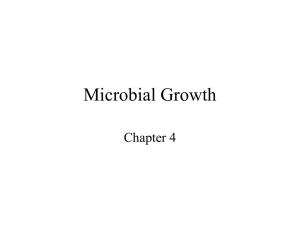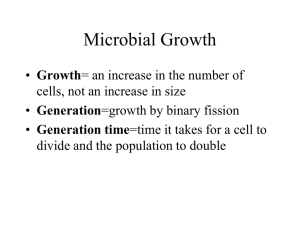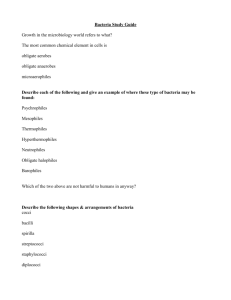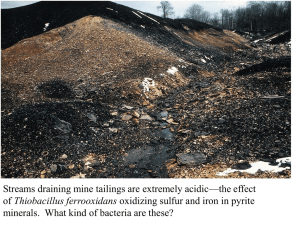Microbial Growth Chapter 4
advertisement
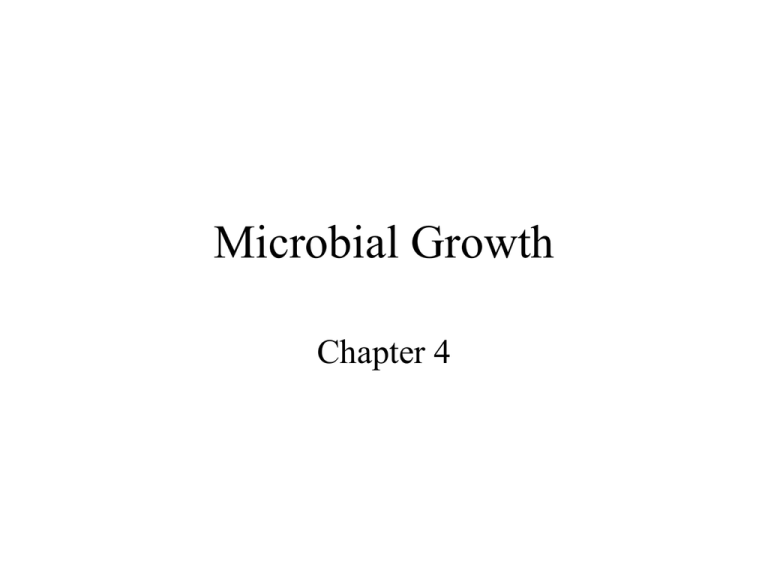
Microbial Growth Chapter 4 Objectives • What are the factors that influence bacteria growth? • Oxygen requirements • Nutrient requirements – Carbon, Nitrogen, Sulfur, Phosphorous • Counting microogranisms Microbial Growth • Growth= an increase in the number of cells, not an increase in size • Generation=growth by binary fission • Generation time=time it takes for a cell to divide and the population to double Bacteria divide by binary fission Biofilms are communities of bacteria Examples of Biofilms Generation times vary for each organism • E. coli – 20 minutes (optimal conditions) • Mycobacterium tuberculosis – 24 hours – 6 week incubation for clinical diagnosis Bacterial growth curve Questions: Antibiotics would have the greatest impact on which phase? Why do microbes enter the stationary phase? At which phase(s) would spores be formed? Primary and Secondary metabolites Metabolites are required for growth Metabolites are required for survival Requirements for bacterial growth • Environmental factors that influence – Temperature, pH, osmotic pressure, oxygen • Nutritional factors – Carbon, nitrogen, sulfur, and phosphorous – Trace elements Optimum Growth Temperatures • Psychrophiles– optimum -5 to 15oC • Psychrotrophs– range from 20-30oC • Mesophiles– range from 25-45oC • Thermophiles– range from 45-70oC pH influences the growth • Bacteria-prefer a pH range of 6.5-7.5 • Molds prefer a pH range of 5.0-6.0 Osmotic environment influences growth Oxygen preferences of organisms • Obligate aerobes • Facultative anaerobes • Obligate anaerobes Why can some organisms grow in the presence of oxygen? • Reactive Oxygen Species are byproducts of Aerobic Respiration • They are extremely toxic to both Prokaryotic and Eukaryotic cells • DNA Damage Oxidize Amino Acids Inactivate Enzymes Disrupt Membranes Activate Immune System Why can some organisms grow in the presence of oxygen? • Toxic forms of oxygen need to be neutralized by enzymes – Superoxide dismutase • Accepts electrons to make H2O2 – Catalase • Converts to 4H2O2 to 2H2O + 2O2 – Peroxidase Oxygen Preferences of Bacteria Candle jars increase CO2 levels for growing capnophiles Anaerobic jars eliminate the oxygen for anaerobes to grow. Chemical requirements: Carbon • What are possible sources of carbon? • Bacteria are classified based on the source of carbon as either heterotrophs or autotrophs Classification based on Energy and Carbon sources Chemical Requirements: Nitrogen • Why do bacteria need nitrogen? Chemical requirements: Sulfur and Phosphorous • Why do bacteria need sulfur? • Why do bacteria need phosphorous? Chemical requirements: trace elements • Small amounts of minerals – Cobalt, zinc, copper, manganese, etc. • Usually function as cofactors Culture Media • Chemically defined – GSA Chemically defined media Culture Media • Complex – Nutrient Agar – TSA – BHI Culture Media • Selective • Differential – Blood • Selective and Differential – EMB Ways to measure bacterial growth • Direct Count • Plate Count/Viable Cell Count • Measure Turbidity Direct Counts Plate counts require dilutions Two techniques for plate counts Turbidity gives a rough estimate
